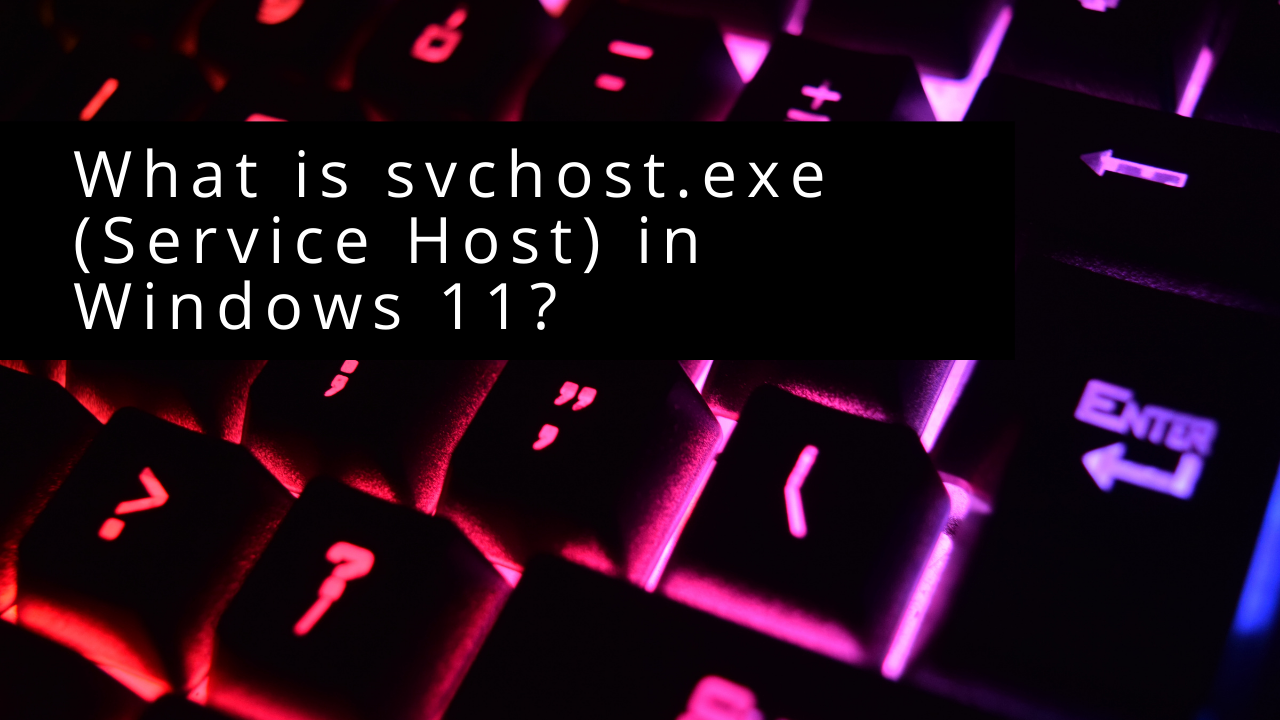What is svchost.exe (Service Host) in Windows 11?

svchost.exe, short for Service Host, is a core system process in Windows 11 that acts as a container for multiple Windows services. These services, implemented as dynamic-link libraries (DLLs), are essential for various functions such as networking, security, printing, and more.
Understanding how svchost.exe works can help users better troubleshoot performance issues and recognize potential threats.
Overview: What Does svchost.exe Do?
Windows services are background processes that support key operating system functions. Since DLLs can't run by themselves, they need a host — this is where svchost.exe comes in.
Key Functions of svchost.exe:
- Hosts DLL-based services needed by the OS
- Groups related services to optimize performance
- Provides fault isolation so one failed service doesn’t crash others
- Improves system security through service isolation
How svchost.exe Works in Windows 11
Windows 11 enhances how svchost.exe manages services compared to earlier versions.
Service Grouping & Isolation
- Functional Grouping: Related services like DNS, DHCP, or audio run under the same process group.
- Crash Protection: If a service fails, others remain unaffected.
- Resource Control: Each svchost instance gets isolated memory and security privileges.
Multiple Instances Are Normal
When you open Task Manager, you'll notice several svchost.exe processes running. Each one manages a different set of services, allowing Windows to:
- Balance performance
- Reduce risk
- Simplify troubleshooting
Essential Services Managed by svchost.exe
Here’s a breakdown of what types of services run under svchost.exe:
- Networking: DNS Client, DHCP Client, Network List Service
- Updates: Windows Update background processes
- Audio: Windows Audio, Audio Endpoint Builder
- Printing: Print Spooler for local and network printers
- Security: Windows Defender, Firewall services
- Automation: Task Scheduler and background task execution
Technical Insights
DLL Hosting
Services are implemented as DLL files. svchost.exe loads them and manages execution in memory.
Process Management
Each instance:
- Runs with distinct user permissions
- Has its own process ID
- Can be monitored and controlled individually
Why Are There So Many svchost.exe Processes?
Benefits of Multiple Instances
| Reason | Benefit |
|---|---|
| Performance | Lower memory overhead, efficient execution |
| Security | Sensitive services are isolated to prevent system-wide compromise |
| Debugging | Easier to identify problematic services via Task Manager |
How to Monitor and Manage svchost.exe in Windows 11
Using Task Manager
- Open Task Manager (Ctrl + Shift + Esc)
- Go to the Processes tab
- Look for entries labeled "Service Host: [service name]"
- Expand them to see the list of services in that group
- Right-click → Properties to view the path, status, and dependencies
Checking File Location
- Legitimate location:
C:\Windows\System32 - If you find
svchost.exerunning from any other directory, it could be malware
Is svchost.exe Safe?
Yes — if it's from the correct location and signed by Microsoft. However, malware can imitate it.
How to Verify Legitimacy
- Check digital signature: Right-click → Properties → Digital Signatures
- Run antivirus scan: Use Windows Security or a trusted third-party tool
- Monitor network traffic: Use tools like GlassWire or Resource Monitor
- Upload to VirusTotal: For a multi-engine virus scan
- Use Windows Sandbox: Run suspicious files in isolation
Common svchost.exe Issues
High CPU or RAM Usage?
Often linked to a misbehaving service rather than svchost.exe itself.
Fix it by:
- Opening Task Manager
- Expanding the svchost.exe using high resources
- Identifying and restarting the offending service via services.msc
Unusual Network Activity?
This can happen due to:
- Windows Update
- Telemetry and diagnostics
- Malware posing as svchost.exe
Always validate the file location and monitor behavior with a firewall or network monitor.
Security Tips: Protecting svchost.exe
| Tip | Why It Matters |
|---|---|
| Keep Windows updated | Patches vulnerabilities that malware could exploit |
| Use antivirus software | Detects malicious svchost.exe clones |
| Monitor file location | Always verify it's in C:\Windows\System32 |
| Restrict svchost.exe access | Configure Firewall to block unauthorized connections |
| Use Windows Security | Check controlled folder access and exploit protection settings |
svchost.exe Evolution: Then vs Now
| Version | How it Worked |
|---|---|
| Windows 7/8 | Fewer svchost.exe instances, unrelated services grouped |
| Windows 10/11 | Separate instances per service group → More secure, stable, and efficient |
FAQ: svchost.exe in Windows 11
Q: Why so many svchost.exe processes?
A: Each instance hosts a different group of services. This is by design for performance and isolation.
Q: Can I end svchost.exe processes?
A: No — unless you’re 100% sure. Terminating it can crash critical system functions.
Q: Is svchost.exe a virus?
A: No. But malware can disguise itself using the same name. Check location and digital signature.
Q: What happens if it gets deleted or corrupted?
A: Windows will likely fail to start properly. Avoid deleting this system file.
Summary Table
| Feature | Details |
|---|---|
| File Name | svchost.exe (Service Host) |
| Location | C:\Windows\System32 |
| Safe to End? | No — may terminate critical services |
| Is It a Virus? | Not inherently, but can be mimicked by malware |
| Primary Purpose | Hosting and managing DLL-based Windows services |
| How to Monitor | Task Manager → Expand entries → Check service details |
| Security Best Practices | Keep Windows updated, monitor file path, scan regularly |
Conclusion
svchost.exe is not just another background process — it's a vital engine that keeps Windows 11 running smoothly. By intelligently hosting and managing essential services, it improves both performance and stability. While it is safe and legitimate in most cases, remaining vigilant and verifying its behavior ensures your system stays secure and efficient.